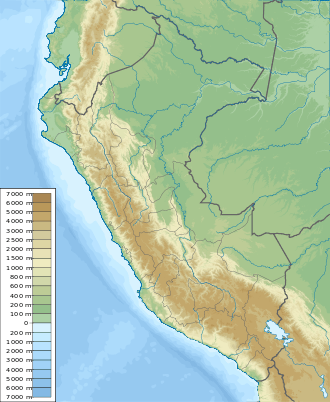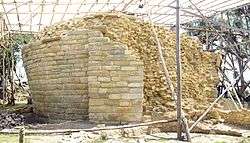Kuélap
Kuélap[1][2] or Cuélap[3] is a walled settlement located in the mountains near the towns of María and Tingo, in the southern part of the region of Amazonas, Peru. It was built by the Chachapoyas culture in the 6th century AD on a ridge overlooking the Utcubamba Valley.
 View of the city walls. | |
 Shown within Peru | |
| Location | Luya Province, Amazonas |
|---|---|
| Type | Settlement |
| History | |
| Founded | 5th century AD - 1100 AD |
| Abandoned | 1532-1570 |
| Periods | Middle Horizon - Late Intermediate |
| Cultures | Chachapoya |
Location
Kuélap is located on a limestone ridge on top of a mountain at an elevation of 3000 metres, on the left bank of the Utcubamba River.[1][4] It belongs to the district of Tingo, Luya Province, Amazonas.[1] The area is covered with cloud forests, with a variety of trees, orchids and epiphytes.[1] The protected zone covers an area of 218.33 ha (2.18 km2) and a buffer zone of 609.67 ha (6.10 km2), both protecting about 12 archaeological sites and the main site of Kuélap.[5]
Architecture

Kuélap is a walled settlement built in a north-south orientation, 584 m long and 110 m in its widest part, making up an area of ca. 6 hectares.[1] The walls are 10 to 20 m high with masonry of limestone blocks finely worked (some blocks may weigh 3 tons).[1]
The city has 3 entrances, 2 to the east and the other one to the west. The main entrance has a trapezoid shape and may have had a corbel arch;[1] it becomes narrower until it allows the passage of one person.[2][4]
There are over 550 structures in the site, circular except for 5 of them (which are quadrilaterals); only the foundations or walls of these structures remain, some of them up to 2 meters high and 50 cm thick.[1][2] Some walls have friezes of rhomboid and zig-zag shapes, which are protected from the rain by cornices.[1] A few of the structures have been restored.[2]
On the southwestern part of the settlement, there is a 5.5 meters high structure known as El Tintero (Spanish for inkwell) or Templo Mayor (Spanish for main temple) which has the shape of an inverted cone; ceremonial archaeological remains have been found there and it is hypothesized that the building may have been used as a solar observatory.[1][2][4]
In the northwestern part, there is a sector known as Pueblo Alto (Spanish for high town), with a wall of 11.5 meters high, which is accessed by two narrow entrances.[1] North of Pueblo Alto, a tower-like structure named Torreón (Spanish for tower) rises up to 7 meters and may have been used for defensive purposes as stone weapons have been found there.[1][2]
At Kuélap, many stones have reliefs with anthropomorphic, zoomorphic and geometric designs.[1] In addition, numerous burials have been found both in the walls and inside the circular structures.[1]
There are also water canals made of stone, which are believed to have supplied water to the settlement from a spring at the top of the mountain.[2]
History
Early history

Human occupation at the site starts in the 5th century AD,[1][2] but the majority of structures were built between 900 and 1100 AD.[2] The city may have had some 3000 inhabitants, but was abandoned in 1570 due to the Spanish Conquest.[5][6] As a consequence the city deteriorated and was covered by tree roots.[6]
Modern history

Kuélap was accidentally rediscovered in 1843, by Juan Crisóstomo Nieto, a judge from the city of Chachapoyas.[7] Then, in 1870, Antonio Raimondi made a survey of the site.[8]
Explorer Charles Wiener visited the site in 1881. In 1939, French general Louis Langlois studied the site and wrote a detailed description of the main buildings. Kuélap was also studied by archaeologists Ernst Middendorf (1887); Adolf Bandelier (1940); spouses Henry and Paule Reichlen (1948); and Arturo Ruíz (1972).[8][9]
Since the 1980s many Peruvian and foreign archaeologists continued with excavations and studies at Kuélap.[8]
Access
Access to Kuelap is gained via El Tingo, a town at approximately 1800m above sea level, near the bank of the Utcubamba. A horse trail also winds along the left bank of Tingo river and leads eventually up to Marcapampa, a small level upland near the site. Access has been made easier in recent years following the completion of a cable car route, which takes the visitor to within 2 km of the fortress[10] from where visitors can walk or often take a horse. The dirt road, adding 37 km to the journey is also still passable.
See also
- List of archaeological sites in Peru
- Gran Pajaten
- Iperu, tourist information and assistance
- Tourism in Peru
References
- "ZONA ARQUEOLÓGICA MONUMENTAL KUÉLAP" (in Spanish). MINCETUR. Archived from the original on 2017-09-05. Retrieved 2017-06-12.
- DK Eyewitness Travel Guide: Peru. Penguin. 2014. p. 250. ISBN 9781465432476.
- Peru 1:100 000, Chachapoyas (13-h). IGN (Instituto Geográfico Nacional - Perú).
- Bradt, Hilary; Jarvis, Kathy (2014). Trekking in Peru: 50 Best Walks and Hikes. Bradt Travel Guides. pp. 140, 142. ISBN 9781841624921.
- "Kuelap Archaeological Complex - UNESCO World Heritage Centre". whc.unesco.org. Retrieved 2017-06-14.
- "Kuelap Fortress". World Monuments Fund. Retrieved 2017-06-14.
- Incas and Spaniards in the Conquest of the Chachapoyas. 1997. p. 104.
- Narváez, Alfredo. "Breve historia de las Intervenciones en Kuélap". Antiguas civilizaciones en la frontera de Ecuador y Perú (in Spanish). Asociación Amigos del Museo de Sipán. pp. 31–33.
- Bradley, Robert (2005). The Architecture of Kuelap (Ph.D. thesis). Columbia University.
- Andina - Peru News Agency (2 March 2017). "Peru: Cable-car system to bring over 75,000 visitors to Kuelap in 2017". Retrieved 8 March 2020.
kuelap all the information how to go
| Wikimedia Commons has media related to Kuélap. |
| Wikivoyage has a travel guide for Kuélap. |